Lina Medina: Lina Medina’s story is one that defies human comprehension. Born in 1933 in Ticrapo, a remote village nestled high in the Peruvian Andes, she went on to become the youngest confirmed mother in history, giving birth to a healthy baby boy at the astonishing age of 5 years, 7 months, and 21 days.
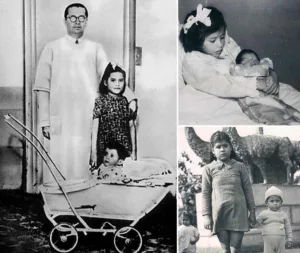
It all began when Lina’s parents, Tiburelo Medina and Victoria Losea, noticed an alarming swelling in their daughter’s abdomen. Fearing a tumor, they rushed her to the hospital in Pisco, a neighboring town. The doctors were initially baffled by the cause of the distention, but a thorough examination revealed a shocking truth: Lina was eight months pregnant.
The news sent shockwaves through the medical community. Precocious puberty, a condition where sexual development occurs much earlier than normal, was already rare, but at such a young age, it was unheard of. Doctors, fearing accusations of a hoax, meticulously documented the case. X-rays confirmed the presence of a fetus, and photographs showcased Lina’s fully developed breasts and wide hips, further emphasizing her unusual physical state.
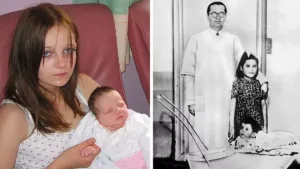
On May 14, 1939, under the care of Dr. Gerardo Lozada and Dr. Pablo Busalleu, Lina underwent a cesarean section due to her small pelvis. The surgery delivered a healthy 5-pound, 8-ounce baby boy, named Gerardo after Dr. Lozada. Despite the initial complications, both mother and child recovered well.
The case of Lina Medina attracted global attention. Newspapers sensationalized the story, scientists flocked to study the phenomenon, and ethical concerns swirled around the circumstances surrounding her pregnancy. The identity of the father remains a mystery, shrouded in speculation and whispers of sexual abuse within the close-knit community.
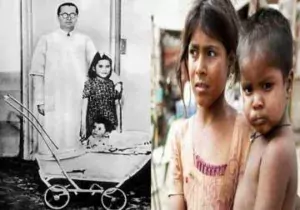
Lina, thrust into the public eye at such a tender age, shielded herself from the outside world. She raised her son, Gerardo, as her brother with the help of Dr. Lozada, who took them both in and provided for their education.
While Gerardo lived a relatively healthy life, he tragically passed away from a bone disease at the age of 40. Lina, meanwhile, went on to live a quiet life in Lima, working as a secretary and eventually marrying. Throughout her life, she maintained a fierce privacy, rarely speaking about her extraordinary experience.
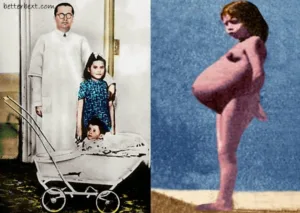
Lina Medina’s story raises complex questions about childhood, sexuality, and societal norms. It highlights the complexities of precocious puberty and the ethical dilemmas surrounding its management.
While some view her case as a medical marvel, others use it to raise uncomfortable questions about exploitation and abuse in vulnerable communities. Regardless of interpretation, Lina Medina’s story remains a fascinating and tragic chapter in medical history, forever etched in the annals of human experience.
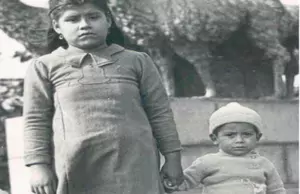
Here are some additional points to ponder:
- The long-term psychological impact of such an experience on both Lina and Gerardo remains largely unexplored.
- The lack of information about the father and the possibility of abuse underscore the importance of child protection measures in remote communities.
- Lina Medina’s case sheds light on the cultural complexities surrounding sexuality and motherhood, particularly in traditional societies.
Lina Medina’s story is a powerful reminder that life is full of unexpected twists and turns. It compels us to confront uncomfortable truths, re-evaluate our understanding of human development, and ultimately, approach each other with empathy and understanding.
In conclusion:
Lina Medina’s story is more than just a medical anomaly. It is a poignant reminder of the resilience of the human spirit, the fragility of childhood, and the enduring mysteries that lie within us all.
WRITTEN BY ALEX
FAQs and answers
1. Who is Lina Medina?
Lina Medina is the youngest confirmed mother in medical history. She was born in 1933 in Peru and gave birth at the age of five years and seven months. Her case remains one of the most extraordinary instances of precocious puberty ever recorded.
📌 Reference: Live Science
2. How Did Lina Medina Become Pregnant?
Lina Medina suffered from a rare condition called precocious puberty, which caused her body to develop reproductive capabilities at an extremely young age. However, the identity of the father was never officially confirmed.
📌 Reference: Medical News Today
3. When and How Did Lina Medina Give Birth?
Lina Medina gave birth via Caesarean section on May 14, 1939, because her small pelvis made natural childbirth impossible. Her baby, a boy named Gerardo, was born healthy, weighing 2.7 kg (6 lbs).
📌 Reference: The Lancet
4. What Happened to Lina Medina and Her Son?
Lina’s son, Gerardo Medina, grew up believing that she was his older sister. He lived a relatively normal life but sadly passed away at the age of 40 due to a bone disease. Lina Medina has since lived a private life.
📌 Reference: History Extra
5. What Were the Medical Explanations for Her Early Pregnancy?
Doctors discovered that Lina Medina had fully developed reproductive organs due to a severe case of precocious puberty, which occurs in about 1 in 10,000 children. However, her case remains one of the youngest ever recorded.
📌 Reference: National Institutes of Health (NIH)
6. Was Lina Medina’s Pregnancy a Hoax?
No, Lina Medina’s pregnancy was medically documented, with X-rays, biopsies, and detailed doctor reports confirming the pregnancy and birth. Many medical professionals have studied her case over the years.
📌 Reference: American Journal of Obstetrics and Gynecology
7. Are There Other Cases of Extremely Young Mothers?
Yes, while Lina Medina remains the youngest confirmed mother, there have been other rare cases of pregnancy at very young ages, such as a 6-year-old in Russia and an 8-year-old in China. However, these cases are extremely rare.
📌 Reference: World Health Organization (WHO)


Comments are closed.